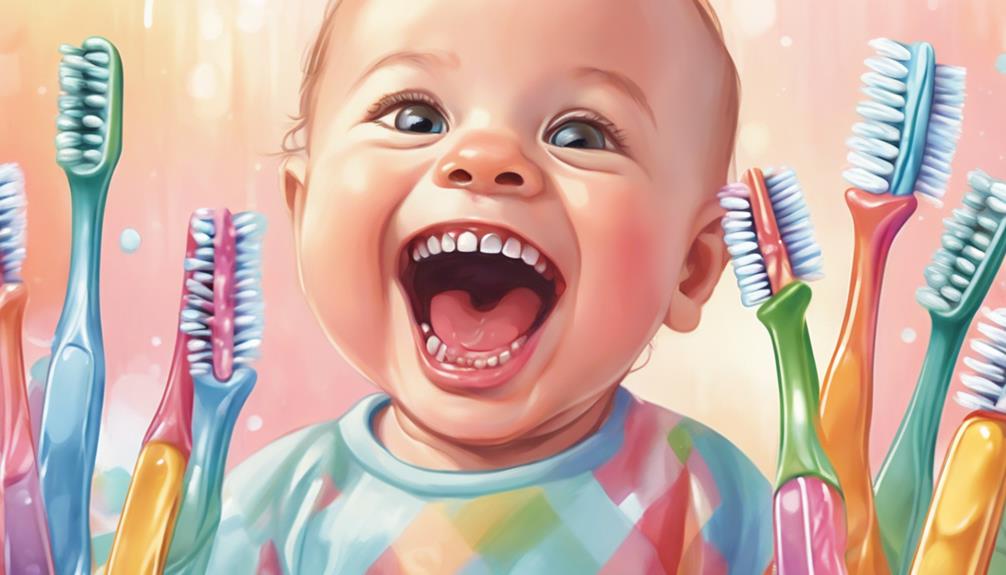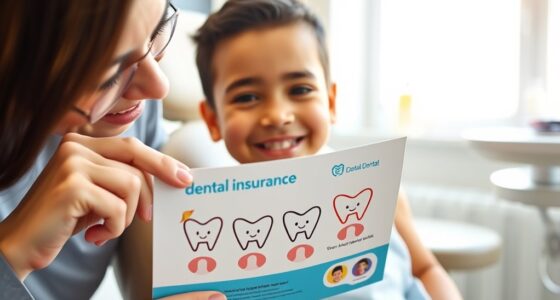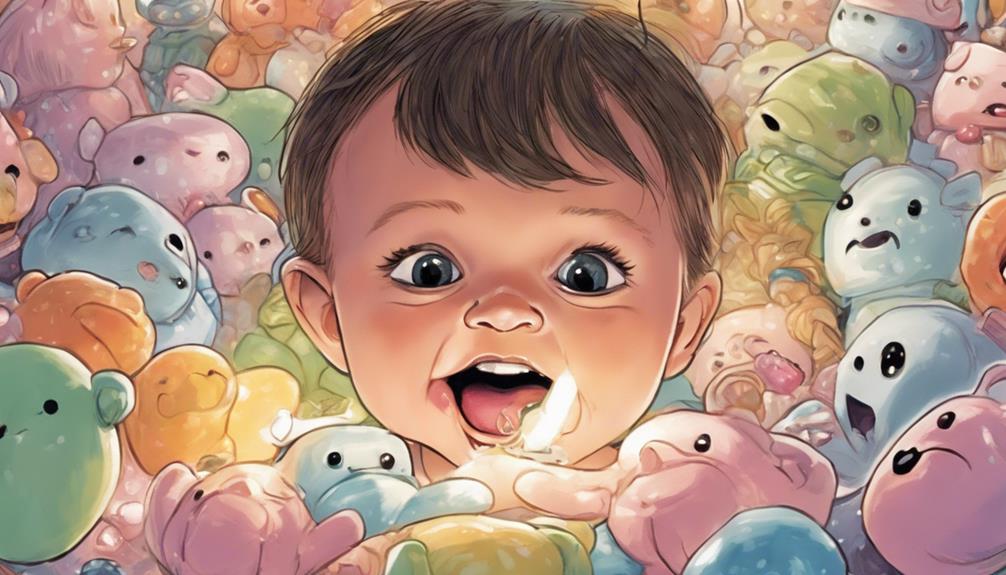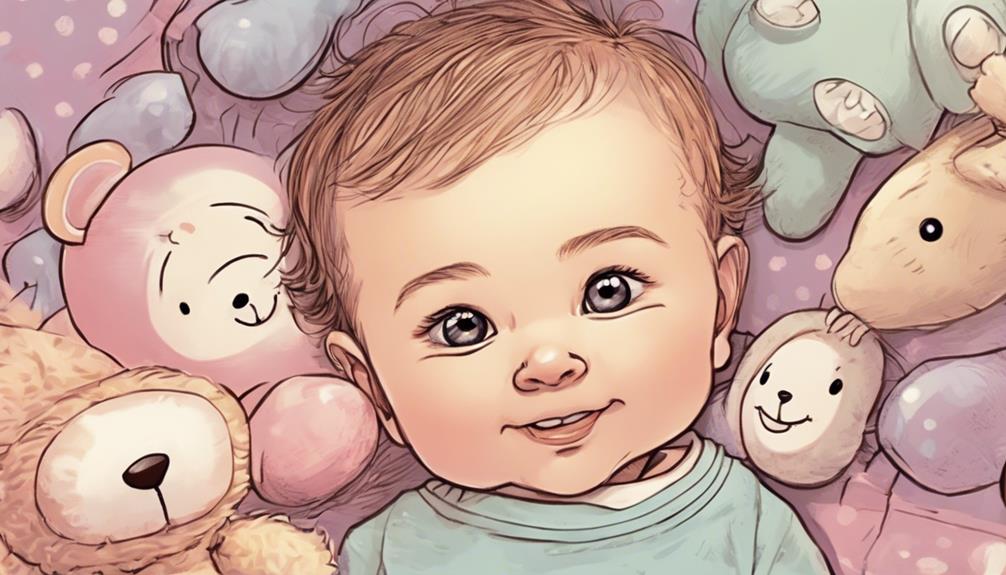Baby teeth typically start to emerge when your little one is about 4 to 7 months old. Most babies begin teething around 6 months, but some might not see their first tooth until their first birthday. The two lower central incisors usually pop through first, followed by the upper central incisors. By the time your child is 3, they should have all 20 primary teeth. You'll notice signs like increased drooling and gum swelling as teething progresses. Knowing the timeline can help you prepare. Stay tuned to discover more about managing discomfort and oral care for those tiny teeth! As the baby teething process continues, you may notice your little one becoming more irritable or fussy. It’s common for babies to experience some discomfort as their teeth come in. Offering a teething toy or gently rubbing their gums with a clean finger can help provide relief during this stage. Remember to continue to monitor their oral hygiene as their teeth come in, as this is an important part of the baby teething process.
Key Takeaways
- Teething typically begins between 4 to 7 months, with most babies starting around 6 months.
- The first teeth to emerge are usually the lower central incisors, appearing between 5 to 7 months.
- By 12 months, most babies have 2 to 4 teeth, while all 20 primary teeth usually come in by age 3.
- Regular dental hygiene should start as soon as the first tooth appears, typically around 6 months.
What Is Teething?

Teething is when your baby's teeth start to push through the gums, usually beginning around 4 to 7 months old. This process marks the arrival of their first teeth, often beginning with the lower central incisors.
You'll notice that as their primary teeth begin to emerge, your baby might show some symptoms associated with teething. These can include increased drooling, a strong desire to chew on objects, and mild irritability.
While some babies experience minimal discomfort, others may feel more pronounced irritation. It's important to recognize these symptoms to help manage their discomfort effectively.
Understanding what teething entails is vital for their dental health, as this natural developmental stage can greatly impact your baby's mood and behavior.
When Does Teething Begin?

Most babies start teething around 6 months old, though some may begin as early as 3 months. You might notice your little one experiencing some discomfort as their first tooth makes its debut.
The average age for the eruption of baby's teeth varies, but here's a general timeline to help you visualize:
- Lower central incisors typically appear between 5 to 7 months.
- Upper central incisors usually follow, erupting around 6 to 8 months.
- Other teeth will come in as the year progresses.
- Some infants mightn't start teething until their first birthday!
As your baby's teeth begin to emerge, you might see signs of teething, such as increased drooling or fussiness.
Teething pain can be uncomfortable, but knowing when to expect these changes can help you prepare.
Signs of Teething

As your baby begins to teeth, you'll likely notice several signs that indicate discomfort and the arrival of those first precious pearly whites.
Increased drooling is one of the most common signs of teething; you might find yourself changing clothes more often due to the mess. Your little one may also show a strong desire to chew on objects, which helps alleviate sore gums.
Irritability is another key indicator. You may observe periods of fretfulness, especially during the night, as teething can disrupt sleep patterns. Pay attention to your baby's gums—if they appear red and swollen, it's a clear sign that teething is underway.
Additionally, you might notice a mild rise in temperature, generally below 38°C (100.4°F). While a flushed cheek can also manifest, remember that high fever or diarrhea isn't typical for teething and could point to other health concerns.
Managing Teething Discomfort

Finding ways to soothe your baby's teething discomfort can make this challenging phase a bit easier for both of you. Here are some effective methods to manage the pain and keep your little one comfortable:
- Gently rub your baby's gums with a clean finger to provide instant relief.
- Offer a chilled teething ring that can numb the soreness in their gums.
- Use cold items like frozen washcloths to soothe those irritated gums.
- Always monitor your baby while using these items to prevent choking hazards.
Teething discomfort is common, and it typically lasts about a week for each tooth. Keep in mind that symptoms may vary based on the tooth's position and timing of eruption.
If the discomfort seems excessive or you're unsure about using any pain relief methods, consult a pediatrician before trying over-the-counter medications.
Oral Care for Baby Teeth

Establishing a consistent oral care routine for your baby's teeth is crucial for promoting good dental health from the very start.
Begin by cleaning your baby's gums with a soft, damp cloth, even before the baby's first tooth appears. Once the first tooth erupts, switch to a soft-bristled toothbrush and use a smear of fluoride toothpaste to gently clean the tooth twice a day. This sets a solid foundation for proper oral care.
As your child grows and learns to spit, you can gradually increase the amount of fluoride toothpaste to a pea-sized amount.
It's important to floss between teeth as they start to touch, typically around age 2 or 3, to prevent plaque buildup and maintain oral health.
Don't forget to schedule your baby's first dental appointment by their first birthday or within six months after the first tooth comes in. This early visit helps monitor dental development and addresses any concerns.
While teething rings can help soothe discomfort, maintaining a consistent oral care routine is essential for your child's healthy smile.
Teething Timeline Overview

Teething usually kicks off between 4 to 7 months, marking an exciting milestone in your baby's development. You'll notice that babies start teething at different times, with some beginning as early as 3 months, while others may not see their first tooth until 12 months.
The teething timeline typically follows a pattern:
- 5 to 7 months: Lower central incisors emerge, your baby's first tooth!
- 6 to 8 months: Upper central incisors begin to appear.
- By 12 months: Most babies have 2 to 4 teeth.
- By age 3: All 20 primary teeth usually make their debut.
As you navigate this stage, remember that every baby is different, and some may sail through teething while others face more discomfort.
Understanding this timeline can help you prepare for the changes ahead, ensuring you're ready to support your little one through this vital period in their oral health journey.
Order of Tooth Eruption

Understanding the order in which your baby's teeth erupt can help you anticipate what's coming next in their dental development. Generally, the first baby tooth to appear is the bottom central incisors, erupting between 5 to 7 months. Next, you'll likely see the top front teeth, or central incisors, between 6 to 8 months.
Here's a quick overview of the order of baby tooth eruption:
| Tooth Type | Eruption Age (Months) |
|---|---|
| Bottom Central Incisors | 5 – 7 |
| Top Central Incisors | 6 – 8 |
| Top Lateral Incisors | 9 – 11 |
| Bottom Lateral Incisors | 10 – 12 |
| Complete Set (20 Teeth) | By 3 years |
After the central incisors, the top lateral incisors typically come in between 9 to 11 months, followed by the bottom lateral incisors around 10 to 12 months. By age 3, most children will have their complete set of primary teeth, including all the incisors. Understanding this order of baby teeth will make the process smoother for both you and your child.
Safe Teething Remedies

Finding effective safe teething remedies can make a world of difference for your little one during this uncomfortable phase. You want to alleviate their discomfort while ensuring their safety. Here are some remedies that can help soothe those sore gums:
- Chilled teething rings or frozen washcloths: The cold numbs the pain and provides relief.
- Gentle gum massage: Use a clean finger to massage your baby's gums, easing their discomfort.
- Teething biscuits: These can be a tasty distraction, but you need to monitor them closely to prevent choking hazards.
- Cold fruits: Offering small pieces of cold, soft fruits can be soothing and nutritious.
Importance of Dental Check-ups

Scheduling regular dental check-ups is essential for your child's oral health, especially after those first teeth begin to emerge.
Ideally, you should schedule your baby's first dental visit by their first birthday or within six months after the first tooth erupts. This early visit promotes healthy development and helps establish a dental home, creating a comfortable environment for future visits.
During these check-ups, pediatric dentists provide valuable guidance on proper oral hygiene practices and dietary recommendations to prevent tooth decay.
They can also apply fluoride varnish, which strengthens tooth enamel and reduces the risk of cavities.
Routine check-ups allow for the detection of any early signs of dental issues, ensuring timely intervention that can lead to better long-term oral health outcomes.
Common Teething Myths

You might be surprised to learn that many common beliefs about teething aren't true.
For instance, teething doesn't cause high fever or diarrhea, and relying on amber necklaces for relief can be risky.
Let's clear up these myths so you can feel more confident in caring for your little one.
Teething and Diarrhea Myth
Teething is often mistakenly blamed for diarrhea in infants, but there's no scientific evidence linking the two; instead, diarrhea usually signals other health concerns.
Parents often misinterpret common teething symptoms like increased drooling and fussiness as signs of gastrointestinal issues. It's vital to differentiate between normal teething discomfort and symptoms of illness.
When your baby is teething, watch for these signs:
- Increased drooling
- Fussiness and irritability
- Mild discomfort in the gums
- Chewing on objects
While some babies may run a mild temperature during teething, a true fever (above 100.4°F or 38°C) typically suggests an underlying infection or illness.
According to pediatric guidelines, understanding the difference between normal teething symptoms and signs of more serious health issues is important.
If you notice diarrhea alongside other unusual symptoms, consult your pediatrician promptly. Staying vigilant not only helps you manage your baby's teething journey but also guarantees that any potential illness gets the attention it needs.
Fever Misconception Explained
How can parents navigate the confusion surrounding fever and teething when many believe that a high temperature is a normal part of the process?
It's important to understand that teething typically doesn't cause high fevers. You might notice a slight temperature rise below 38°C, but anything higher usually signals an illness.
Many parents also fall for myths linking teething with gastrointestinal symptoms like diarrhea. Research shows no direct connection; such symptoms often arise from other factors. While some babies might experience mild discomfort during teething, severe irritability isn't common. In fact, many children remain pain-free throughout the process.
Another misconception is that teething can lead to rashes. Although drooling can cause skin irritation, a full-body rash isn't a symptom of teething.
Knowing these facts helps you differentiate between normal teething symptoms and signs of potential health issues. If your child exhibits high fever or other concerning symptoms, don't hesitate to seek medical advice.
Amber Necklace Effectiveness
Many parents turn to amber teething necklaces, believing they offer natural relief for their child's discomfort, but scientific evidence fails to support this claim.
Despite their popularity, these necklaces can actually pose serious risks. Consider the following:
- Choking hazards: Loose beads can break off, posing a risk to infants.
- Strangulation risks: The necklace can wrap around a child's neck, leading to dangerous situations.
- Lack of scientific evidence: Studies show that amber doesn't alleviate teething symptoms like irritability or drooling.
- Anecdotal evidence: Many claims about amber's effectiveness stem from traditional beliefs, not reliable research.
While it might be tempting to rely on amber teething necklaces due to anecdotal stories, it's essential to prioritize your child's safety.
Embrace safer methods to help ease your little one's teething discomfort. Always consult a pediatrician for guidance on managing teething symptoms effectively.
Frequently Asked Questions
When Should I Expect My Baby's First Teeth?
You can expect your baby's first teeth to appear between 4 to 7 months. Some babies might start teething as early as 3 months or as late as 12 months, so be patient!
Is It Normal for a 10 Month Old to Have No Teeth?
It's perfectly fine if your little one hasn't sprouted any pearly whites yet. Every baby's teething journey is unique, and many don't show teeth until closer to their first birthday. Just keep monitoring their overall health.
What Is the Average Age Babies Start Teething?
Babies typically start teething around 6 months, though some may begin as early as 3 months or as late as 12 months. It's normal for each child to have a unique teething timeline.
When Do Babies Get Each Tooth?
You'd think getting teeth would be straightforward, right? Babies typically get their lower central incisors first, around 5-7 months, followed by upper ones at 6-12 months, and more teeth continue appearing until age 3.
Conclusion
In the journey of your baby's early dental development, teething can feel like a rollercoaster ride of emotions and discomfort.
By understanding the signs and managing their pain, you can help make this change smoother.
Remember, every tiny tooth that erupts is a stepping stone toward their beautiful smile.
Keep up with oral care and regular dental check-ups to guarantee their little pearly whites grow strong and healthy.
You've got this, and your baby's smile will shine bright!









